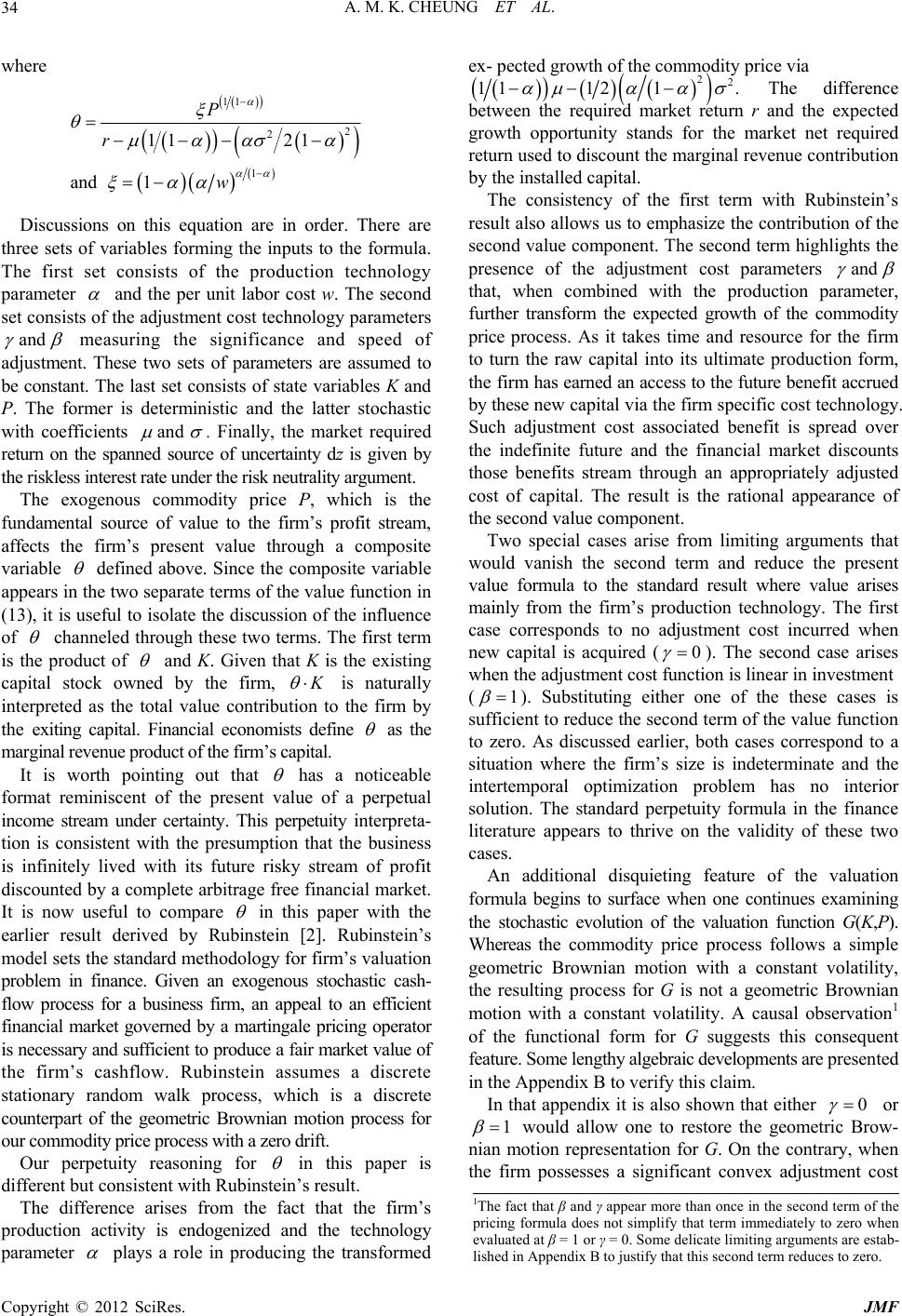
A. M. K. CHEUNG ET AL.
34
where
11
2
2
1
11 21
and 1
P
r
w
Discussions on this equation are in order. There are
three sets of variables forming the inputs to the formula.
The first set consists of the production technology
parameter
and the per unit labor cost w. The second
set consists of the adjustment cost technology parameters
and
measuring the significance and speed of
adjustment. These two sets of parameters are assumed to
be constant. The last set consists of state variables K and
P. The former is deterministic and the latter stochastic
with coefficients and
. Finally, the market required
return on the spanned source of uncertainty dz is given by
the riskless interest rate under the risk neutrality argument.
The exogenous commodity price P, which is the
fundamental source of value to the firm’s profit stream,
affects the firm’s present value through a composite
variable
defined above. Since the composite variable
appears in the two separate terms of the value function in
(13), it is useful to isolate the discussion of the influence
of
channeled through these two terms. The first term
is the product of
and K. Given that K is the existing
capital stock owned by the firm,
is naturally
interpreted as the total value contribution to the firm by
the exiting capital. Financial economists define
as the
marginal revenue product of the firm’s capital.
It is worth pointing out that
has a noticeable
format reminiscent of the present value of a perpetual
income stream under certainty. This perpetuity interpreta-
tion is consistent with the presumption that the business
is infinitely lived with its future risky stream of profit
discounted by a complete arbitrage free financial market.
It is now useful to compare
in this paper with the
earlier result derived by Rubinstein [2]. Rubinstein’s
model sets the standard methodology for firm’s valuation
problem in finance. Given an exogenous stochastic cash-
flow process for a business firm, an appeal to an efficient
financial market governed by a martingale pricing operator
is necessary and sufficient to produce a fair market value of
the firm’s cashflow. Rubinstein assumes a discrete
stationary random walk process, which is a discrete
counterpart of the geometric Brownian motion process for
our commodity price process with a zero drift.
Our perpetuity reasoning for
in this paper is
different but consistent with Rubinstein’s result.
The difference arises from the fact that the firm’s
production activity is endogenized and the technology
parameter
plays a role in producing the transformed
ex- pected growth of the commodity price via
22
1112 1.
The difference
between the required market return r and the expected
growth opportunity stands for the market net required
return used to discount the marginal revenue contribution
by the installed capital.
The consistency of the first term with Rubinstein’s
result also allows us to emphasize the contribution of the
second value component. The second term highlights the
presence of the adjustment cost parameters and
that, when combined with the production parameter,
further transform the expected growth of the commodity
price process. As it takes time and resource for the firm
to turn the raw capital into its ultimate production form,
the firm has earned an access to the future benefit accrued
by these new capital via the firm specific cost technology.
Such adjustment cost associated benefit is spread over
the indefinite future and the financial market discounts
those benefits stream through an appropriately adjusted
cost of capital. The result is the rational appearance of
the second value component.
Two special cases arise from limiting arguments that
would vanish the second term and reduce the present
value formula to the standard result where value arises
mainly from the firm’s production technology. The first
case corresponds to no adjustment cost incurred when
new capital is acquired (0
). The second case arises
when the adjustment cost function is linear in investment
(1
). Substituting either one of the these cases is
sufficient to reduce the second term of the value function
to zero. As discussed earlier, both cases correspond to a
situation where the firm’s size is indeterminate and the
intertemporal optimization problem has no interior
solution. The standard perpetuity formula in the finance
literature appears to thrive on the validity of these two
cases.
An additional disquieting feature of the valuation
formula begins to surface when one continues examining
the stochastic evolution of the valuation function G(K,P).
Whereas the commodity price process follows a simple
geometric Brownian motion with a constant volatility,
the resulting process for G is not a geometric Brownian
motion with a constant volatility. A causal observation1
of the functional form for G suggests this consequent
feature. Some lengthy algebraic developments are presented
in the Appendix B to verify this claim.
In that appendix it is also shown that either 0
or
1
would allow one to restore the geometric Brow-
nian motion representation for G. On the contrary, when
the firm possesses a significant convex adjustment cost
1The fact that β and γ appear more than once in the second term of the
ricing formula does not simplify that term immediately to zero when
evaluated at β = 1 or γ = 0. Some delicate limiting arguments are estab-
lished in Appendix B to justify that this second term reduces to zero.
Copyright © 2012 SciRes. JMF